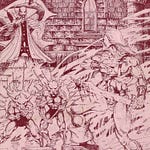White Dwarf Issue #7, published Jun/Jul 1978, celebrates the magazine’s first anniversary, a significant milestone in the evolution of specialist hobby publications dedicated to science fiction and fantasy gaming. This issue debuts the illustrious full-colour cover, a visual testament to the growing enthusiasm and sophistication of the science fiction and fantasy gaming community. Ian Livingstone’s editorial acknowledges that the magazine will feature more advertising than usual, which contributes to the higher page count, raising concerns about the balance between editorial content and commercial space.
The magazine actively encourages reader participation, soliciting submissions for regular features such as The Fiend Factory, which showcases new monsters, and Treasure Chest, which offers additions for D&D. Reader letters are published, and Ian Livingstone goes so far as to offer free issues for accepted monster submissions, underscoring a commitment to interactive content. A reader questionnaire included in this issue highlights the editorial team’s desire for feedback and continuous improvement. The classifieds further connect clubs, GMs, and players, advertising major events like Gen Con XI and Origins ‘78, as well as local gatherings in cities across Europe. The magazine also reports on the opening of Games Workshop’s new premises in Hammersmith.
The review of Bifrost is particularly scathing about the lack of proofreading, citing numerous printer errors and omissions that render the rules confusing and incomplete. It is criticised for being released in incomplete volumes, making it unplayable without all parts. Lords and Wizards is faulted for imbalance and vague rules. The Sorcerer’s Cave is described as too simplistic for experienced players, and The Warlord Game is deemed too dull with fewer players.
My favourite section, Molten Magic, highlights new miniatures from manufacturers such as Asgard, Greenwood & Ball, Oracle, and Ral Partha, some of which are still among my favourite manufacturers to this day. True professionals will note the inclusion of miniature codes for ease of cataloguing. The magazine also announces that Games Workshop is now manufacturing Ral Partha figures under licence in the UK and that Asgard Miniatures is producing McEwan Miniatures under licence. Meanwhile, the Open Box offers critical evaluations of new games and rulebooks, including The Warlord Game, The Thieves of Fortress Badabaskor, Bifrost, Lords and Wizards, and Cosmic Encounter. Each review breaks down the strengths and weaknesses of the products, providing an overall rating while aiming for objectivity by relying on independent authorities or the White Dwarf Test Panel. New releases and price changes are also noted, keeping readers informed about the latest developments.
The magazine has some marvellous in-depth articles that go beyond mere product listings. For instance, Ed Simbalist’s Feudal Economics in C&S addresses gaps in the Chivalry & Sorcery rules by offering a detailed system for determining starting funds based on social class, family status, and even horoscope. John T. Sapienza, Jr.’s Carrying Capacity provides a structured approach to encumbrance in fantasy roleplaying, considering factors like strength, body weight, race, and gender (gulp, don’t cancel me) and supplying a practical equipment list and movement rates. The Asbury System introduces a method for calculating experience points for magical items, aiming to standardise what had previously been a vague area. Don Turnbull’s Lair of the Demon Queen delivers a complete mini-dungeon for D&D, with detailed room descriptions, monster encounters, traps, and puzzles, offering ready-to-use content for GMs.
Philosophical debates about gaming also find a home in this issue. The letters section and a featured article engage with the nature of D&D, particularly the interpretation of combat and armour class. Roger Musson’s views are countered by Albie Fiore and Gary Gygax, the latter emphasising that D&D is a heroic fantasy game where characters are not meant to die from random chance but rather to experience progression and fun. Gygax’s own article, Thoughts on the Proliferation of Magic Items in D&D, warns against the unchecked distribution or sale of magic items, arguing that it can unbalance campaigns and undermine player engagement. Advocating for magic items to be hard-won rewards and even suggests that GMs should find ways to remove them from high-level characters to maintain challenge. The letters section also addresses the issue of authority in D&D, with contributors arguing against the idea of a central council dictating rules.
In summary, White Dwarf #7 is a seminal publication of its era, striking a balance between product coverage, in-depth discussions of game mechanics, and practical resources for GMs. Its commitment to community engagement and fostering debate cements its place as a key contributor to the early development and popularisation of science fiction and fantasy gaming, even as it grapples with the challenges of editorial quality and evolving industry standards.












Share this post